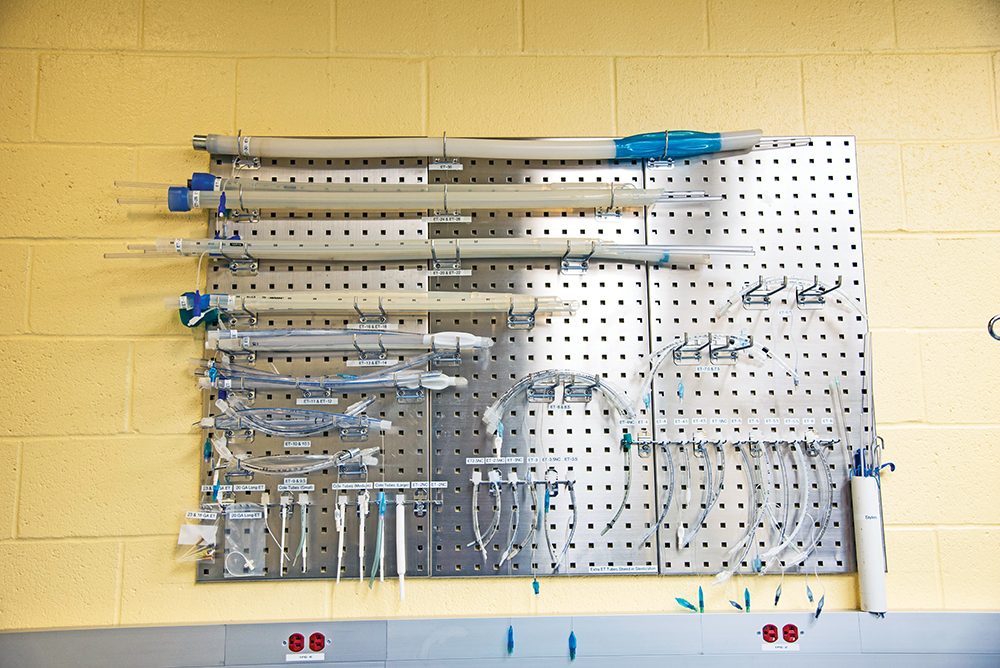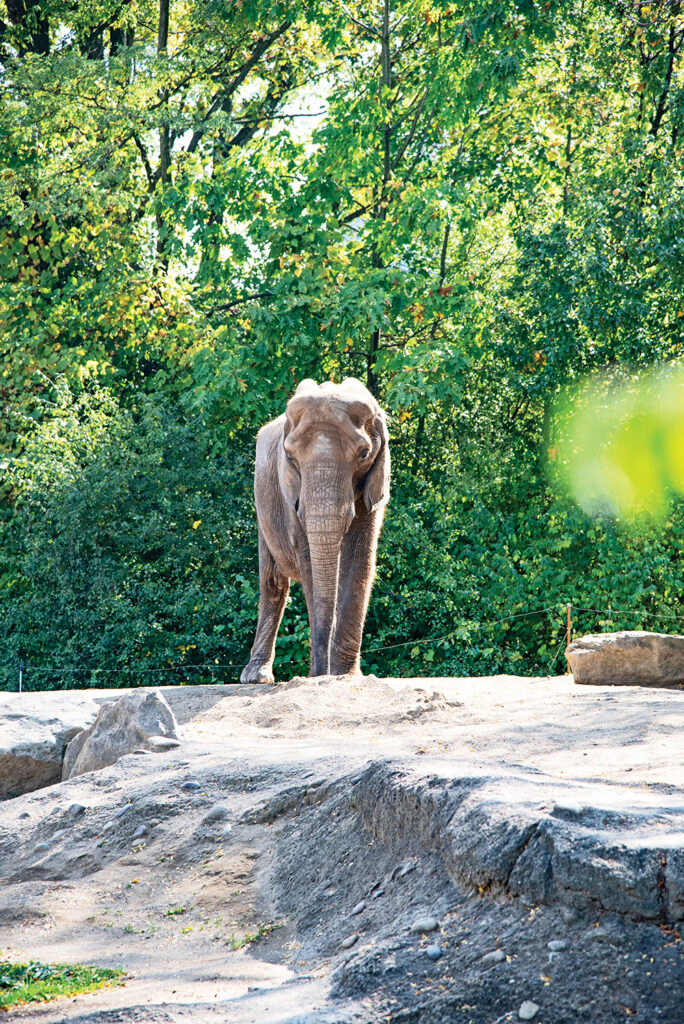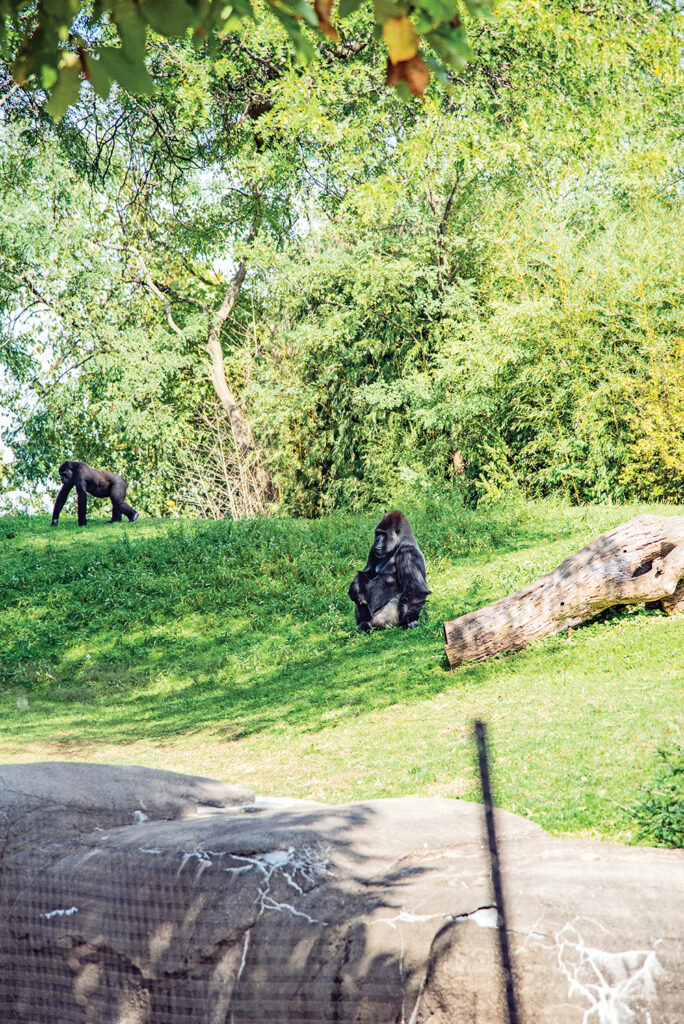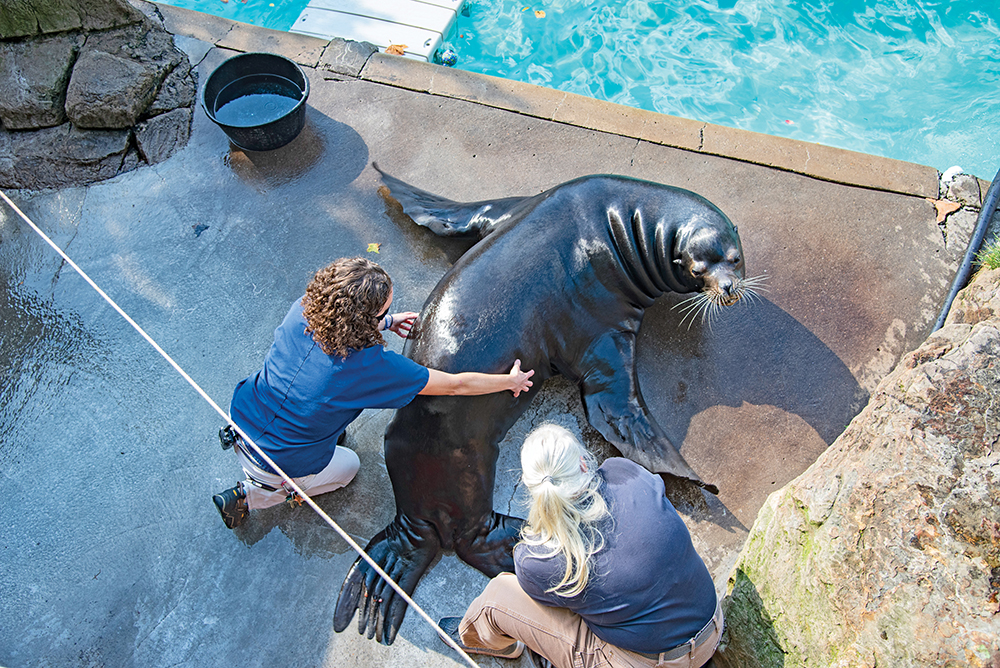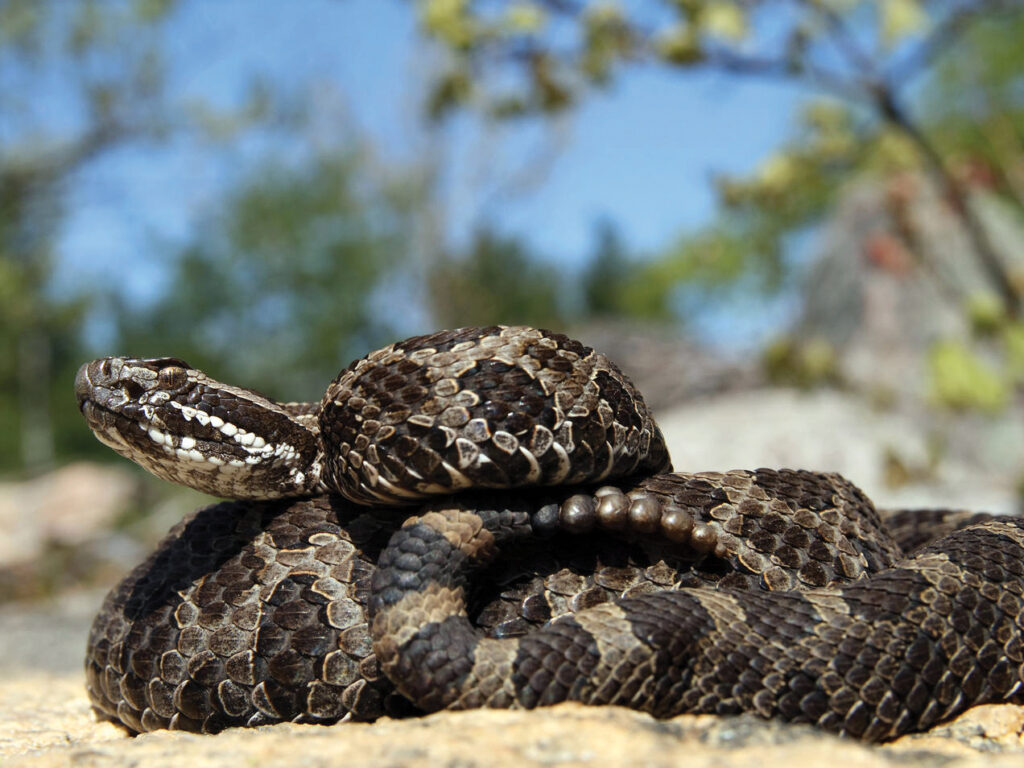By Darrach Dolan
An alumna finds more than a career at the Pittsburgh Zoo
Libby Burns ’01 meets us at the staff entrance to the Pittsburgh Zoo and PPG Aquarium. Although she is wearing a protective mask, I can see the warmth of her smile in her eyes. She unlocks the gate and welcomes us — Kendra Tidd, the magazine’s designer and photographer, and I have traveled here to learn about Burns’ journey from Wilson College graduate to head veterinary technician at the zoo.
We are wearing protective masks and greet one another from a safe social distance. Not only are we abiding by the appropriate COVID-19 protocols for our own safety and the safety of others, but we’re doing so for the safety of the animals as well. Burns explains that no one knows for sure which species may be susceptible to the virus, so they are taking extra precautions to prevent the transmission of the virus from humans to the zoo animals. Naturally, the staff are particularly concerned about the primates because of their close genetic kinship with humans. However, lions and tigers at the Bronx Zoo developed the disease, and thousands of farmed mink across Europe have become infected. So the strategy is to assume every species is susceptible until science says otherwise.
Burns takes us on a tour of the veterinary and quarantine center. It is a large building with surgery, examination, and treatment suites as well as a mini-laboratory, pharmacy, and large quarantine areas. It’s immaculately clean and, surprising to me, empty. In fact, the only patient is a meerkat curled up asleep in a cat carrier.
It is there to have blood work done and will be returned to its enclosure before we finish the tour. When I tell Burns I was expecting to see more animals in the unit, she laughs. Unlike a general veterinary practice, they do not have a constant flow of animals coming through their center. Instead, they emphasize preventative care and try to keep the animals healthy and catch illness before it requires them to be moved from their enclosures.
“All our primates get vaccinated, including for the flu,” she says. “We just got some giant anteaters, and, lo and behold, they’re susceptible to the flu as well and need to get vaccinated. In the world of exotic animals, there’s always something new to learn or something new that comes up.”
Burns says that there are many other differences between being a veterinary technician – a vet tech, as everyone calls them — at a zoo and at a general practice. When you are dealing with everything from a tiny tree frog to an 18-foot giraffe, you need to equip yourself for all possibilities. She shows us the operating room. Along one wall, there is an enormous variety of intubation tubes — the plastic tubes inserted into the windpipe to keep a sedated patient’s airways unobstructed. They range in size from thread-like IV catheters they use on lizards to tubes you could roll a baseball through. Of course, some of the animals — the elephants, giraffes, and many of the larger herbivores — are too large to be treated in the center. For these creatures, the vets and vet techs travel to the patients and have a van equipped with many of the machines and equipment to perform procedures in the “field.”
“We do a lot of the CBCs (complete blood counts) and other workups by hand, just like I learned at Wilson,” she says as we tour the lab. “I’ve heard from a lot of tech students that this is something that isn’t taught much anymore because there are machines to do it. For your cats and dogs and horses, that might be easy, but for the variety of species that we have and with the different sizes and types of blood cells, we do it all by the old hemocytometer like the one I learned on at Wilson.”
She recalls, “At Wilson, we had to buy our own hemocytometer coverslips because they wanted us to take care of them and not break them. Then I started ordering them here and realized they weren’t that expensive. But it did teach me to take care of them.”
Blow-darting a Lioness
We enter a storage room where they have a dart gun rack. Darting animals to deliver medications, such as antibiotics, or to sedate them to examine them or treat them is another big difference between the zoo and general practices. Burns jokes that darting animals was one of the few things Wilson hadn’t prepared her for.
When she did an internship at the zoo, one of her first jobs was to draw a picture of an orangutan on a poster board and place the board against hay bales for staff to practice darting.
There are two types of dart guns — CO2 powered and blowguns. The latter are exactly what you would think — hollow pipes the vet tech or vet blows through to propel the darts into the animals. Blow-darting is often the preferred method because it is quieter and less stressful to the animal. Plus, the operator can adjust the power depending on how close or far away the target is. When Burns began at the zoo, she had to learn how to dart immediately. She remembers drawing different types of animals on poster board and practicing at every opportunity she could. These days the staff hone their skills on a 3D deer target.
The first animal she darted was Sheba, an African lion — the lioness had a mild infection and needed a course of antibiotics delivered through darts. “I lined up my shot and I knew I could do it because I had practiced so much. She was lying down and not moving. I took a deep breath and took the shot. As soon as it discharged and hit her, Sheba came flying down towards the front of the mesh. I swear my hair went flying back, and my mouth was hanging open,” Burns says. “Cathy, the lead carnivore keeper, was standing beside me and, as Sheba came roaring down, she said, ‘Libby, shut your mouth because sometimes when they come roaring at us, they spray urine.’ So, I shut my mouth. She came down so quickly, and with such force, my chin just dropped. I don’t think Sheba ever forgave me.”
Finding Wilson and A Dream Internship
When we finish the tour of the facility, we sit in the conference room, masks still on. Burns has always loved animals and wanted a career involving them from an early age. Throughout high school, she worked at a local vet’s office in Penn Hills, a suburb of Pittsburgh. When it came time to go to college, she was looking for a program that would allow her to get certified as a vet tech upon graduation. A program in Pittsburgh had been her first choice. But the institution lost its accreditation and was no longer an option.
“I was at a job fair with my parents when I walked by a table for Wilson and saw pictures of a veterinary suite,” Burns says. “I realized that there I could get a bachelor’s degree as well as work towards a career I was really interested in.” The decision to go to Wilson is one she is glad she made. “The extra schooling I got there helped me mature as a person. Some of the techs we see who have an associate degree, it’s like they’re right out of high school. They aren’t as mature as Wilson grads and aren’t even sure what they’re getting into. Whereas having a longer and more varied experience and, you know, talking with professors and having professors with different backgrounds, you can be more sure that this is what you want to do.”
When it came time to do an internship — required for graduation by the College — Burns decided she wanted to do hers at her hometown zoo. “We were encouraged to take the initiative by the College. I knew a student a few years ahead of me who’d done an internship at the Louisville zoo and had a wonderful experience.” At the time, the Pittsburgh Zoo didn’t have a formal internship pro-gram, and there was no application process. Burns was undeterred. “I printed out my resume and cover letter and went to the zoo, paid admission, and decided to drop it off. I saw an employee come from the office, and the employee took it from me and said they’d get it to the vet.”
Burns had no idea if her material would get to the right person and worried that she had wasted her time. Luckily, the employee was as good as her word, and Burns got a call from the zoo. She explained the hours she would need to get the credits for the internship and the zoo agreed. “I learned so much just by watching. They didn’t let me touch the animals much. I was allowed to draw blood a couple of times, but unlike a lot of Wilson students at regular practices who got a lot of practice drawing blood and things like that, I didn’t get as much hands-on experience.”
What Burns did get was certainty — the experience working with the team confirmed that she wanted to be on the zoo track, and she was determined to do whatever it took to make that happen. Given there are a finite number of zoos in the country and a lot of people eager to work at them, the competition for jobs is fierce.
The vet Burns had interned with advised her to first hone her basic vet tech skills at a general practice, then work at a practice that sees a lot of exotic pets, then work with an emergency care practice. If she built a resume that included these three types of practices, she would be prepared for the ever-changing patients and situations a zoo tech encounters regularly.
A Dream Job Opens, Closes, and Opens Again
After graduating from Wilson, Burns found work as a board-certified vet tech at an emergency care clinic in Pittsburgh. While there, “I got a call from the zoo. They were hiring, and they remembered me and said, ‘Hey, we know you’re not out of school long, but what do you think about applying?’” Burns thought her dreams had come true only to have them dashed almost immediately.
“After I applied, I got another call, and they said, ‘Actually, we’re thinking of making it a head tech position, and we don’t think you qualify for that.’” Burns, once again, was undeterred. “I said, ‘You’re right, I don’t qualify. But what if I could come in and do a practice interview, and you can see how far I’ve come along?’ This was 2002, only one year out of college, but I persuaded them to let me come in to do a practice interview because I figured I’d need to do one eventually.”
She did the interview and got to meet the new vet and new vet tech — the ones she had interned with had left in the interim. “Much later, they called and said they didn’t find anyone they liked for the head tech position, so they were going to make it an associate vet tech position, and would I be interested. I was absolutely!” And, simple as that, she landed her dream job.
Burns is self-effacing and puts getting the job down to good luck and being in the right place at the right time. I point out that she took the initiative to apply for the internship in the first place and, later, persuaded them to give her a practice interview for a job she wasn’t qualified to do. I suggest she created her own “good luck.”
Burns considers this. She nods but is not inclined to take full credit. Somebody, she doesn’t know who, but it must have been someone she met while interning there, had recommended her to the new veterinary team when the job was first announced. That was the key piece of luck that got her the original call.
“This is what I tell my students,” Burns says, speaking about the vet and vet tech students who do internships at the zoo these days. “You never know what an internship can lead to. It can be a foot in the door. You don’t want to be just here and not taking it seriously. You want to make a good impression on everyone and not just the vets, but even the zookeepers who will be helping you with a procedure. And the other technicians and support staff. You can make an impression, and you never know who will remember you when an opportunity comes up.”
Family Planning for Elephants and Hand-rearing a Gorilla
There are so many highlights of her time at the zoo that she struggles to list them. She remembers the births of her first two elephants vividly. She explains that family planning for elephants can be a challenge for a zoo. “Female elephants have two hormonal surges. The first one does not cause them to ovulate, but the second one does. The theory is that in the wild, the males pick up on the hormones in the environment and start following the herd more closely. The second hormonal surge happens a few weeks after the first, and by that time, the bulls are there, and they can breed.” The problem with elephants in captivity is that you want the male to be with the females for the second surge, not the first.
The zoo had two females cycling very closely to one another. Burns and the team had to take blood from them and monitor their hormonal levels. After they recorded the first hormonal surge, they had to take regular samples and send them out to a special lab and await the results. The fear was they would miss the second surge and miss the opportunity to breed the elephants. It turns out they have since learned that canine tests work on elephants, and they could have monitored the samples themselves using them. But at the time, they were dependent on the outside lab and hoped they could time it perfectly.
As an elephant matchmaker, Burns was a success on her first try — the zookeepers introduced the male after each female’s second hormonal surge, and both females got pregnant. The team continued monitoring them throughout their 18-month pregnancies. Burns followed the growth of the fetuses through ultrasounds and blood work. She felt an intimate connection with both mothers and babies.
Towards the end of the gestation period, Burns was taking blood daily because progesterone levels change dramatically when elephants are about to give birth. “I don’t know how many nights I spent here because I was not going to miss this,” she says. “I got to see these two babies born, and that was a highlight for me. They turned 12 this year — two females, Angeline and Zuri.”
Another highlight was the birth of a lowland gorilla named Ivan. Shortly after his birth, his mother developed mastitis and couldn’t feed him. So, the staff had to hand-rear him and took turns sleeping overnight on a cot with the baby gorilla. Burns, who was “very pregnant” at the time, enjoyed the opportunity to hone her parenting skills with this newborn. Ivan thrived, and they were able to return him to his mother. The mother gorilla, still unable to feed her baby herself, learned to go to the staff for his bottle of formula and they fed him with that.
Burns takes us on a tour of the zoo, and we see Ivan, now a healthy and rambunctious seven-year-old, playing with his younger brother in the gorilla enclosure.
The Pup Who Kept Coming Back
We accompany Burns to the sea lion pool. There she meets the head vet and Director of Animal Health Ginger Sturgeon, DVM. One of the zookeepers has alerted them to a problem with a female sea lion — she appears to have injured a front flipper and is avoiding putting weight on it. They examine and observe the sea lion as the zookeepers feed the females and pups. They conclude that the injury is probably not too serious but will require monitoring.
Feeding time for sea lions is made into a game that stimulates and exercises them. “The sea lions are almost like golden retrievers — they love to retrieve and play. That sort of interaction with animals is something you miss from a regular domestic animal practice. Not that I snuggle with sea lions or anything,” Burns says.
After the females and pups are fed, it’s time to bring out the male. His name is Seahawk, and he is enormous — a gentle giant, he kisses Burns through her protective mask. “Seahawk is an interesting story,” she tells us. “He came here in 2006 but was born in the wild. As a pup, he was a repeat strander. The first time he was dehydrated and underweight. So [the rescuers] rehydrated him and fed him well and then took him out and released him to a pod of sea lions. But within a few days, he came back even though he seemed physically okay. I think they give them three chances. The third time they took him out to another, larger pod, really far out in the ocean, and said, ‘Now go find your people.’ They joked that he nearly beat them back to shore.”
After that, they realized he did not want to return to the wild, and they would have to find him a new home. “When he came here in 2006, he was this little nugget, and now he’s enormous and has fathered many pups,” Burns says.
More Than a Job
As we leave the sea lion area, we bump into Dr. Sturgeon. I ask her to tell me about Burns and what she brings to the zoo. “Libby is one of the most skilled, knowledgeable, and all-around fantastic technicians I have known in my whole life,” she says. “It is an honor to be her right-hand person as the head veterinarian. She makes the place run, she is approachable to staff, and she is overall really, really good at what she does. She is good with the animals, the public, and the staff.”
Dr. Sturgeon adds, “I can trust her with confidential information. I can trust her to give me parenting advice. I can trust her to be a sounding board and help me be a better person in real life or as a manager. There are few people in this world I trust as much as Libby.”
When I ask Burns, who has worked her way from associate veterinary technician to becoming the head veterinary technician, how she would sum up her career at the zoo so far, she says, “Not only did I find a career, but I’ve found my family.”
Advice for Wilson Students
Burns accompanies us back to where we are parked. She says that Wilson College’s four-year veterinary technician program was perfect for her. “I feel like for myself, I wanted to have at least a BA as well. If I found I didn’t want to pursue the [vet tech] career, I would have that to fall back on. And there were also vet tech students who, after year two, realized it wasn’t for them and chose a different path. Having the extra time to figure it out is really helpful.”
Before we say goodbye, Burns has some advice for Wilson students. “When you do an internship, put your best foot forward because you never know where it will lead. I’ve had students who have realized that after the internship here, yes, this is what I want to do. And others who have realized it’s not for them. Either way, you learn something important through these shadowing and interning experiences.”
Hellbenders and Rattlesnakes
The Pittsburgh Zoo and PPG Aquarium is known for supporting the conservation of wild animals around the world. What is less known is that the zoo and its staff support conservation efforts closer to home.
“You hear of zoo vets or techs traveling to exotic places to work with mountain gorillas,” Libby Burns ’01 says. “But one of the cool things we got to do was work with the Pennsylvania Department of Conservation and Natural Resources (DCNR) on eastern massasauga rattlesnakes.”
These indigenous snakes have been in decline in Pennsylvania — most likely due to habitat loss. Smaller and more docile than the eastern timber rattlesnake, massasaugas need the combination of access to wetlands where they overwinter and natural prairie where they bask and hunt. DCNR researchers wanted to track the snakes to learn more about them to better preserve or improve the few habitats where breeding populations still exist. The researchers caught snakes, the zoo team anesthetized them and placed trackers in them, and the researchers released them back where they had originally found them.
“We got to go into the field and help them track, which was really fun,” Burns says. “We placed trackers in some pregnant females. The researchers got to track them and see where they gave birth, and if the offspring did well. That was cool to participate in wild research in our own backyard.”
Burns also worked with eastern hellbenders — a large aquatic salamander that can grow up to 29 inches long. The females lay strings of eggs in nest cavities the males have dug in riverbeds. The females leave, while the males remain to brood and guard the eggs in the underwater nests until they hatch. Also known as “snot otters,” they were once widespread throughout the Appalachian region.
“In the 1800s, people killed them because they thought they ate trout eggs,” Burns says. Today the wild populations have been declining due to habitat loss, pollution, and disease.
Burns got to “go out and do creek research.” She found that where streams and rivers had been restored, and the water quality was good, hellbenders were surviving. The future of the species is unclear. However, in Pennsylvania, where many old dams are being demolished and waterways allowed to flow more freely, there is some hope of local recovery. The hellbender has been named the state’s official amphibian in an effort to draw attention to its conservation.



